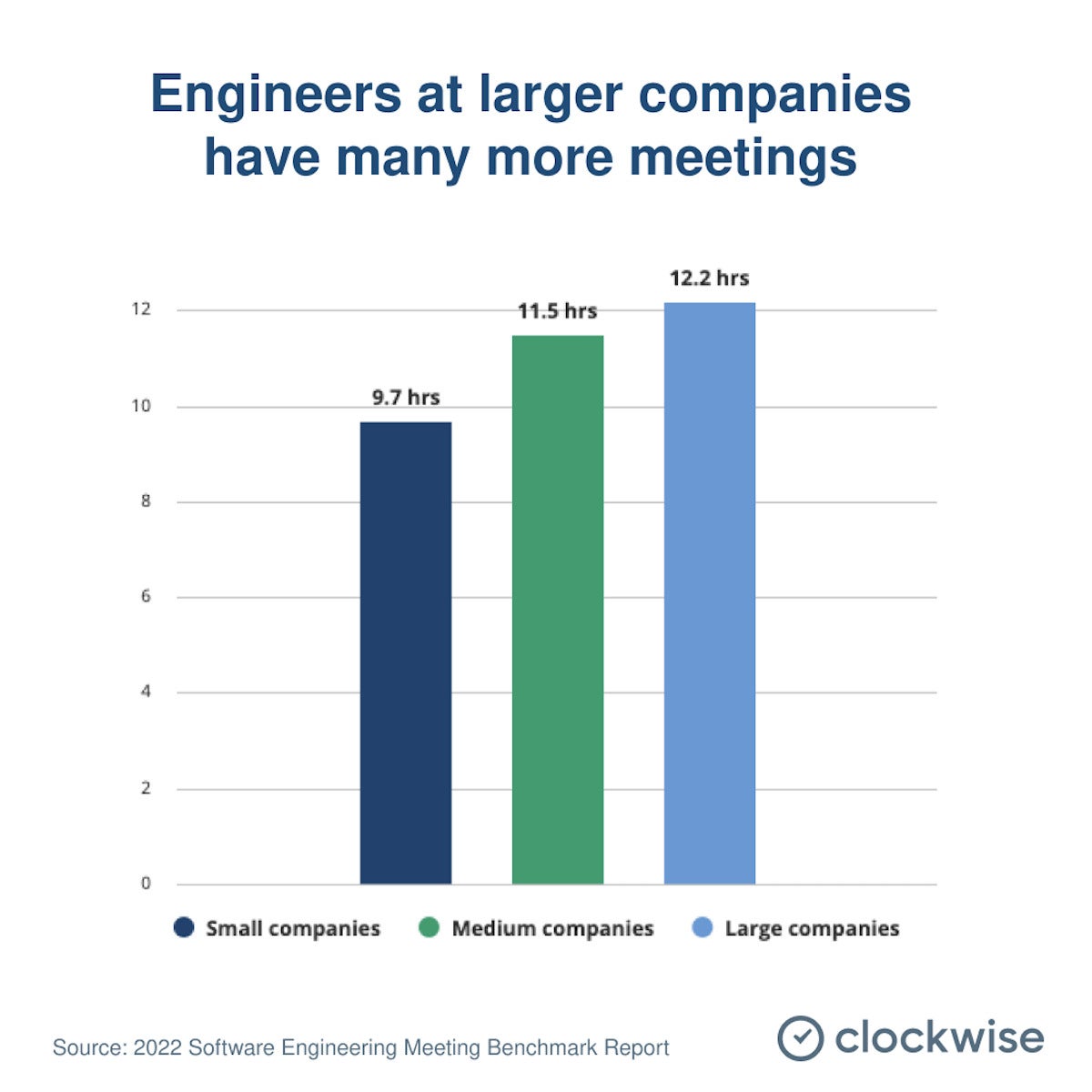Software developers spend a third of their week in meetings on average, according to data collected by time management app Clockwise — with those at large companies facing the most packed schedules.
Clockwise’s data is gathered from 1.5 million meetings tracked by its platform over the course of 12 months up to May 2022, providing an overview of work practices by 80,000 developers at 5,000 companies. It shows that the average software engineer spends 10.9 hours per week in meetings, with 19.6 hours of “focus” time – defined as two or more hours free to concentrate on work.
The remaining six hours are classed as “fragmented”, which refers to the schedule gaps between meetings that provide little opportunity to settle back into completing a task. Separate research has shown that it can take around 23 minutes to refocus after an interruption, and meetings can often be the cause of context switching that distracts workers from more productive work.
The Clockwise report also highlighted the importance of focus time via a survey of 150 software engineering managers. Almost all (90%) correlate focus time with productivity, and most (77%) see a connection with increased revenue for the business.
That’s not to say that meetings aren’t important, but it makes sense for managers to find the right balance for their teams, said Dan Kador, vice president of engineering at Clockwise. “It’s something that companies have to pay attention to and try to understand their meeting culture — what’s working and what’s not working for them.”
“It is important that teams get together to discuss things and make sure they are all on the same page, but often meetings are scheduled at regular intervals even if they aren’t necessary,” said Jack Gold Principal analyst & founder at J. Gold Associates. “We are all subjected to weekly meetings, or other intervals, where, even if there is nothing to discuss, the meeting takes place anyway. And some meeting organizers feel obligated to use up the entire scheduled time.”
Of course, meeting overload is not just an issue for those writing code. “Too much time spent in meetings is not just a problem for developers,” said Gold. “It is a problem across the board for employees in many companies.”
 Clockwise
ClockwiseClockwise found that developers are spend nearly 11 hours in meetings each week.
Unsurprisingly, developers spend more time in meetings as they climb the career ladder and become managers: seven hours more a week on average, according to Clockwise, largely due to an increase in one-to-one meetings.
There is, however, little difference between senior roles. Developers that become managers, directors or vice presidents all spend a similar amount of time in meetings. The same goes for focus time, which drops markedly for managers, but again remains relatively similar for more senior leaders, too.
Another indicator of time spent in conference rooms or staring at a webcam is company size. Developers at large organizations spent an average of 12.2 hours in meetings, compared to 9.7 hours at smaller companies. Those at large and medium-sized businesses also spend 36% more time in one-to-one meetings than those at smaller firms.
And focus time drops from 22.5 hours a week at small companies to 16.9 hours for large businesses.
That happens, said Kador, because more established businesses rely on meetings to make decisions. The bigger they get, the more decisions are required — and that leads to more meetings. “It doesn’t necessarily have to be true, but that’s the way things are often done,” he said.
By contrast, smaller companies are more likely to adopt new ways of working, such as greater reliance on asynchronous communications that don’t require everyone take part at the same time.
 Clockwise
ClockwiseLarger companies tend to have more meetings.
“Larger, more established companies haven’t embraced a more asynchronous way of working as fully,” said Kador, “whether that’s Loom or leaning into Slack or Teams’ audio and video messages…,Notion, Google Docs — the suite of async documentation tools that exist out in the world.”
Gold also sees potential for collaboration and productivity tools to cut down on the need for some meetings.
“With newer collaboration tools, some of the burden of meetings has been reduced, as people can now have ad hoc meetings with just the folks that need to be involved, leaving others to do their thing,” he said. “These tend to be to the point and briefer, and are not as broad, meaning I’m more involved and not tuning out when other things are discussed not relevant to me.
“That doesn’t completely replace periodic group meeting[s], but it does have the potential to reduce the non-productive part of meeting.”
Async tools can replace the daily or weekly standup meeting (which are held on Tuesdays 80% of the time, according to the Clockwise data, making that the day with the least focus time on average). Thirty-five percent of engineering teams have at least one standup a week, and the same proportion have them daily.
While technology can help cut back on meetings, it can also require a cultural change on behalf of management.
Companies can try introducing “no-meeting days” to encourage new meeting habits and drive adoption of async communications, said Kador. “Those are the kinds of things that larger organizations can experiment with,” he said. “My expectation, based on my own career and what I’ve seen in the industry, is they actually have a pretty positive impact.”
Copyright © 2022 IDG Communications, Inc.




